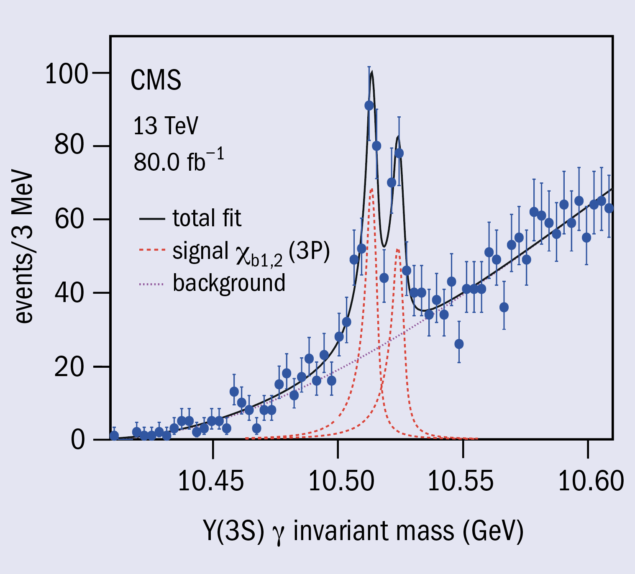
A report from the CMS experiment
Bottomonium mesons, composed of beauty quark–antiquark pairs bound to each other through the strong force, play a special role in our understanding of hadron formation because the large quark mass allows important simplifications in the relevant theoretical calculations.
The spectroscopy of the bottomonium family has now been significantly upgraded, thanks to the first observation of the individual χb1(3P) and χb2(3P) states by the CMS collaboration. Identified via the decay χb(3P) → Υ(3S) γ, and adding for the first time all the LHC data collected at an energy of 13 TeV (corresponding to a staggering 80 fb–1 of integrated luminosity), CMS detected 16.5 million Υ mesons in the dimuon decay channel. The corresponding invariant mass distribution shows well-resolved Υ(1S), Υ(2S) and Υ(3S) resonances (figure 1, inset), which constitute the starting point for the reconstruction of the p-wave bottomonia through the radiative decay χb(mP) → Υ(nS) γ.
The main challenge in this study is the low energy of the photons. The CMS analysis uses photons that convert into e+e– pairs and are reconstructed in the silicon tracker with very high precision, leading to clear χb(mP) peaks in the resulting Υ(nS) γ invariant mass distributions. The resolution of the χb mass measurement scales with the photon energy, or the difference between the masses of the P- and S-wave mesons. The Υ(3S) γ invariant mass is measured with a remarkable resolution, enabling the first observation of a double-peak structure in the χb(3P) resonance, which corresponds to the states of total angular momentum J = 1 and J = 2 (figure 2).

The existence of two peaks is established with a significance exceeding nine standard deviations and the two masses are measured to be 10,513.42 ± 0.41 (stat) ± 0.18 (syst) MeV and 10,524.02 ± 0.57 (stat) ± 0.18 (syst) MeV. The measured mass splitting, 10.60 ± 0.64 (stat) ± 0.17 (syst) MeV, can be used to improve the theoretical calculations, which currently predict values between 8 and 18 MeV depending on the potentials describing the quark–antiquark non-perturbative interaction. The only exception predicts a value of –2 MeV, the negative sign meaning that the χb2(3P) has a mass smaller than the χb1(3P).
The new measurement is a step forward in completing the spin-dependent bottomonium spectroscopy diagram, and should significantly contribute to an improved understanding of the non-perturbative QCD processes that lead to the binding of quarks and gluons into hadrons.
Further reading
CMS Collaboration 2018 arXiv.org:1805.11192.





